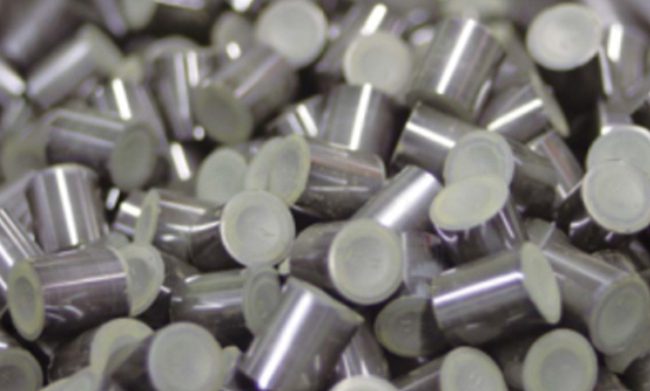Japan Moving Forward on Nuclear Accident Tolerant Fuels
Efforts by Japanese nuclear fuel manufacturers to develop accident-tolerant fuel (ATF) materials are making progress, and their commercialization is currently expected between 2030 and 2035 after key demonstrations, the Japan Atomic Energy Agency (JAEA) reported in April.
Full-scale development of ATF, an industry term used to describe new technologies that further enhance the safety and performance of nuclear materials, has been ongoing in Japan since 2015, the country’s nuclear energy research and development (R&D) agency noted. In other countries, ATF technologies had been under development since the early 2000s, but R&D efforts received a marked boost in the wake of the Fukushima accident in March 2011.
 |
|
Developed under a federal program to increase the accident tolerance of conventional uranium dioxide fuel pellets, advanced doped pellet technology (ADOPT) fuel pellets feature an increased uranium density that “significantly enhances the safety and reliability of pressurized water reactors as well as enables customers to improve fuel cycle economics and extend their operating cycles,” Westinghouse said. Courtesy: Westinghouse |
In the U.S., a program bolstered by the Department of Energy’s (DOE’s) Office of Nuclear Energy (ONE) to explore advanced light water reactor (LWR) fuel with enhanced accident tolerance has already progressed to testing fuel within operating commercial reactors. ONE’s program continues to support industry initiatives to install the first commercial quantities of ATF by the mid-2020s, as well as qualify fuel for use at higher burnup levels.
Near-term concepts include coated cladding, high-burnup fuel, higher enrichment levels, and long-term concepts such as fuel with silicon carbide cladding and also the use of higher-density fuels. In March, notably, Westinghouse received the U.S. Nuclear Regulatory Commission’s approval to use its advanced doped pellet technology (ADOPT) fuel pellets in U.S. pressurized water reactors (PWRs).
Accidence Tolerance a Critical Goal for Nuclear in Japan
In Japan, ATF R&D has been bolstered by national efforts to foster a safety culture based on the accident at Tokyo Electric Power Co.’s (TEPCO’s) Fukushima Daiichi nuclear power plant, which comprised six boiling water reactors (BWRs). The accident on March 11, 2011, was largely prompted by a rapid temperature rise after a tsunami inundated backup power supplies and interrupted critical cooling functions at Daiichi Units 1, 2, and 3. A reaction between the zirconium of the units’ fuel-cladding tubes and water vapor generated a large amount of hydrogen, and the gas and radioactive materials discharged into the primary containment vessel (PCV) as TEPCO depressurized the reactor pressure vessels (through wet well venting).
According to JAEA, Japanese nuclear fuel manufacturers including Toshiba Energy Systems and Solutions are developing silicon carbide cladding tubes for BWRs and PWRs. Mitsubishi Heavy Industries (MHI) and the Mitsubishi Nuclear Fuel Co. are separately also developing chrome cladding tubes for PWRs. GE Hitachi Nuclear Energy and Global Nuclear Fuel-Japan are meanwhile working to improve stainless steel cladding tubes for BWRs. JAEA said it is “engaged in the development of core manufacturing technology and the promotion of cooperation among the manufacturers.”
JAEA Executive Director Hiroyuki Oigawa in April, however, acknowledged that Japan’s ATF development suffers from a lack of irradiation reactors. Testing has largely been conducted overseas, he noted. Test data to date has mostly been accumulated utilizing experimental reactors abroad and a domestic accelerator facility, he noted.
Among JAEA’s international collaborations, for example, is a four-year agreement with the U.S. DOE to share facility space at Idaho National Laboratory’s (INL’s) Transient Reactor Test (TREAT) facility. TREAT is one of just a handful of reactors in the world specifically designed to bring nuclear fuels to failure in a controlled environment. “The test reactor produces sudden bursts of energy, known as transients, that are five times more powerful than a commercial power plant to allow scientists to examine fuel performance,” the DOE explained.(INL also offers irradiation testing of ATF concepts in its Advanced Test Reactor.)
Industry group Japan Atomic Industrial Forum (JAIF) has highlighted the significance of Japan’s ATF development, given the country’s recent adoption of policy to restart as many of its 33 operable reactors as possible and prolong the operating life of aging ones beyond their current 60-year limit. The policy also encourages the construction of new nuclear power plants to replace decommissioned reactors.
“In March and December 2022, JAEA held workshops on ATF development for all domestic stakeholders,” JAIF noted in a recent brief. “At the time, JAEA’s engineer in charge said, ‘In terms of short-term economic rationality alone, ATFs can be purchased from the U.S., whose development of the equipment was ahead of Japan’s. But when it comes to technological infrastructure and maintaining and ensuring human resources over the medium and long term, independent development is necessary,’ thus emphasizing the significance of the matter,” the group reported.
The Fuel Security Imperative
Japan is also one of five countries that signed an agreement on April 16 at the G7 Nuclear Energy Forum in Sapporo, Japan, to displace Russia’s influence in the global nuclear fuel supply chain, JAIF noted. That agreement, also signed by the U.S., Canada, France, and the UK, will pave the way for multilateral collaboration on the nuclear front end, including “strategic opportunities in uranium extraction, conversion, enrichment, and fabrication.”
While the envisioned supply of “civil nuclear technology, equipment, or materials” would be subject to applicable domestic laws, regulations, and international agreements, the countries said the alliance would enable them to “strengthen [their] domestic sectors and establish a level playing field to compete more effectively against predatory suppliers.”
—Sonal Patel is a POWER senior associate editor (@sonalcpatel, @POWERmagazine).